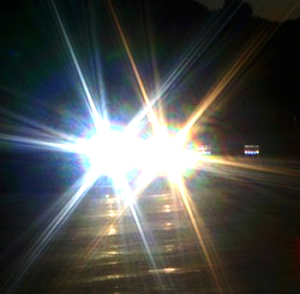 Most adults have experienced discomfort or disability glare at some point. For example, disability glare is what a driver experiences from the high-beam headlights of oncoming traffic at night, or when facing towards the sun when it is low in the sky. These and many other sources of glare typically involve bright lights in a relatively darker field, making it difficult to see objects near the source of glare, often obscuring a person’s vision for some time after their exposure.
Most adults have experienced discomfort or disability glare at some point. For example, disability glare is what a driver experiences from the high-beam headlights of oncoming traffic at night, or when facing towards the sun when it is low in the sky. These and many other sources of glare typically involve bright lights in a relatively darker field, making it difficult to see objects near the source of glare, often obscuring a person’s vision for some time after their exposure.
At night (or when in low light environments) our vision is limited. Low lights decrease depth perception and peripheral vision causing the pupils to dilate, often blurring vision. Machine operator vision is paramount to haul road safety in a mine site. The eye takes considerable time to adapt to ambient light levels, and constantly varying illumination in an operator’s field of vision is of particular concern. Disability glare occurs when very bright LED work lights in the field of view of an operator are poorly aimed, or have low quality optics (or both). This is a common occurrence on mine sites, the result of a proliferation of poor quality LED work lights and lack of an industry standard for mine site traffic lighting.
Whether at night or underground, operating heavy machinery can be a daunting task for even the most accomplished drivers. The effect of high output LED work lights with poor optical control on oncoming traffic, results in the occurrence of disability glare. Glare from the work lights of oncoming haul trucks and other mine site traffic can temporarily blind drivers, and is particularly invasive as it can also cause temporary dizziness and confusion, leading to serious safety concerns for mine workers and operators. Traffic fatality rates are three to four times higher at night than during the day, which partly correlates with a likelihood that drivers are driving tired, or stressed. The International Commission on Illumination (CIE) states that on a mine site, 35% of all mine site safety incidents are attributed to inadequate or incorrect lighting setups. These dangers can be significantly reduced by ensuring optimal visual acuity and by eliminating as many risk factors as possible.
A viable and robust industry specification to govern the installation and optical pattern of work lights and illumination levels is critical for the installation of a lighting system on mining mobile equipment. This specification would eliminate the occurrence of disability glare for mine site traffic, whilst ensuring an ergonomic and easily repeatable lighting setup can be achieved across the mobile equipment fleet of a mine site.








